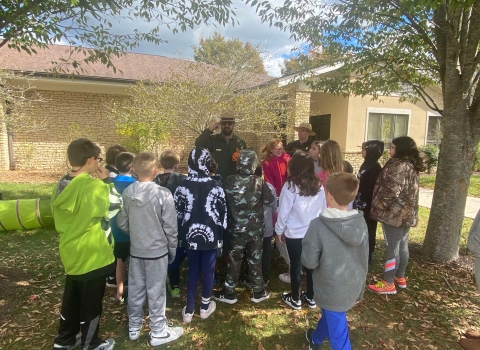How do you save a venomous snake from extinction? Some may even ask, why do we want to? We at the U.S. Fish and Wildlife Service have worked with our partners to finalize a recovery plan for the eastern massasauga rattlesnake, a shy, reclusive snake listed as threatened under the Endangered Species Act. The final plan is now available to guide efforts by conservation partners to save the species.
“We’re often asked why it’s important to save a snake, especially a venomous species,” said Charlie Wooley, regional director for the Service’s Great Lakes Region. “Snakes like the massasauga play an important role in the ecosystem. And even if you don’t like snakes, you probably appreciate the wildlife that relies on this massasauga’s habitat: butterflies, herons, eagles, game species, songbirds and fish. When we conserve the eastern massasauga, all these other species benefit.”
We listed the eastern massasauga rattlesnake as threatened under the Endangered Species Act in 2016, after finding its population had declined over the past three decades due to loss and fragmentation of its wetland habitat, among other threats. The goal of the eastern massasauga recovery plan is to stop the species’ decline and ensure its long-term survival. Recovery actions for the eastern massasauga focus on reducing threats to existing populations by addressing habitat loss, along with impacts from flooding and drought, disease and intentional killing.
Recovery planning is one step in a process to address threats to endangered and threatened species. Plans provide a road map for private, tribal, federal and state cooperation in conserving listed species and their ecosystems. While a recovery plan provides guidance on how best to help listed species achieve recovery, it is not a regulatory document. The public is invited to provide input as the plan is developed. Once a recovery plan is finalized, recovery partners outline specific actions in an implementation strategy.
The eastern massasauga is a small, thick-bodied rattlesnake that lives in shallow wetlands and adjacent uplands in portions of Illinois, Indiana, Iowa, Michigan, Minnesota, New York, Ohio, Pennsylvania, Wisconsin and Ontario. Throughout its range, biologists have confirmed that less than half of the eastern massasauga’s historical populations still exist. Most of those populations are in Michigan and Ontario, Canada.
The eastern massasauga is a natural part of our environment that has evolved over millennia; it has an ecological role within its communities, and conserving it and its habitat benefits a suite of plants and animals. The eastern massasauga is both predator and prey. It eats small mammals (mice and shrews) and small snakes, helping to keep their numbers in check. At the same time, it is food for raptors and other snakes.
Conserving eastern massasaugas means conserving the wetlands and adjacent uplands where they live. In addition to providing wildlife habitat, wetlands benefit people by storing floodwaters and filtering sediments and other pollutants from water eventually used for drinking and recreation.
Many partners have already made progress in conserving the eastern massasauga and its habitat. Before the species was listed, the Michigan Department of Natural Resources recognized the need to manage some of its lands to conserve the snake. We worked with the DNR on a candidate conservation agreement with assurances that made it easier for the DNR to manage its lands now that the snake is listed. Through the agreement, Michigan DNR has enrolled more than 2.7 million acres of land that will be managed to benefit the snake, covering a large area of the species’ range in Michigan.




